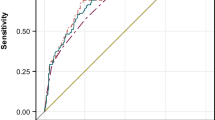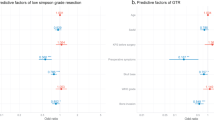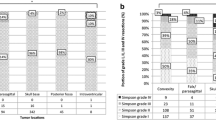Abstract
Microsurgical resection is the primary treatment of skull base meningiomas. Maximal resection provides the best tumor control rates but can be associated with high surgical morbidity. To understand the relation between extent of resection (EOR) and functional outcome we have analyzed the neurological improvement and recurrence rate in a large consecutive series of skull base meningioma patients. In addition, we defined anatomical and biological factors predictive for recurrence and overall outcome. We investigated 226 skull base meningioma patients receiving tumor resection in our institution. The most frequent location was the medial sphenoid ridge (29.6 %). EOR was rated according to the Simpson scale. Overall performance was measured by the Karnofsky performance score (KPS); neurological deficits were quantified using the Medical Research Council Neurological Severity Score (MRC-NPS). Complete resection was achieved in 62.8 % and the EOR was significantly correlated to tumor location. The morbidity and mortality rate was 32.1 and 2.7 % respectively, new permanent neurological deficits occurred in 3.5 % of all patients. From all patients with focal neurological deficits, 60.1 % experienced significant improvement. Both the MRC-NPS and the KPS significantly improved from the preoperative status to discharge, however the improvement rate was dependent on the tumor location. Recurrence rate was 15.5 %; tumor size, bone- and venous sinus infiltration, WHO grade, poor EOR but not MIB-1 labeling index were independent factors predictive for recurrence. Microsurgical resection of skull base meningiomas improves neurological impairment in the majority of patients. Specific risk factors for recurrence require consideration for postoperative management.


Similar content being viewed by others
References
Riemenschneider MJ, Perry A, Reifenberger G (2006) Histological classification and molecular genetics of meningiomas. Lancet Neurol 5:1045–1054
Marosi C, Hassler M, Roessler K, Reni M, Sant M, Mazza E, Vecht C (2008) Meningioma. Crit Rev Oncol Hematol 67:153–171
Sutherland GR, Sima AAF (1991) Incidence and classification of meningiomas. In: Schmidek HH (ed) Meningiomas and their surgical management. Saunders, Philadelphia, pp 10–21
Adachi K, Kawase T, Yoshida K, Yazaki T, Onozuka S (2009) ABC Surgical Risk Scale for skull base meningioma: a new scoring system for predicting the extent of tumor removal and neurological outcome. Clinical article. J Neurosurg 111:1053–1061
McGregor JM, Sarkar A (2009) Stereotactic radiosurgery and stereotactic radiotherapy in the treatment of skull base meningiomas. Otolaryngol Clin North Am 42:677–688
Hug EB, Devries A, Thornton AF, Munzenride JE, Pardo FS, Hedley-Whyte ET, Bussiere MR, Ojemann R (2000) Management of atypical and malignant meningiomas: role of high-dose, 3D-conformal radiation therapy. J Neurooncol 48:151–160
Ichinose T, Goto T, Ishibashi K, Takami T, Ohata K (2010) The role of radical microsurgical resection in multimodal treatment for skull base meningioma. J Neurosurg 113:1072–1078
Bassiouni H, Ntoukas V, Asgari S, Sandalcioglu EI, Stolke D, Seifert V (2006) Foramen magnum meningiomas: clinical outcome after microsurgical resection via a posterolateral suboccipital retrocondylar approach. Neurosurgery 59:1177–1185 discussion 1185–1177
Sandalcioglu IE, Gasser T, Mohr C, Stolke D, Wiedemayer H (2005) Spheno-orbital meningiomas: interdisciplinary surgical approach, resectability and long-term results. J Craniomaxillofac Surg 33:260–266
Mathiesen T, Lindquist C, Kihlstrom L, Karlsson B (1996) Recurrence of cranial base meningiomas. Neurosurgery 39:2–7
Bassiouni H, Asgari S, Sandalcioglu IE, Seifert V, Stolke D, Marquardt G (2009) Anterior clinoidal meningiomas: functional outcome after microsurgical resection in a consecutive series of 106 patients. Clinical article. J Neurosurg 111:1078–1090
Seifert V (2010) Clinical management of petroclival meningiomas and the eternal quest for preservation of quality of life: personal experiences over a period of 20 years. Acta Neurochir (Wien) 152:1099–1116
van Alkemade H, de Leau M, Dieleman EM, Kardaun JW, van Os R, Vandertop WP, van Furth WR, Stalpers LJ (2012) Impaired survival and long-term neurological problems in benign meningioma. Neuro Oncol 14:658–666
Zentner J, Meyer B, Vieweg U, Herberhold C, Schramm J (1997) Petroclival meningiomas: is radical resection always the best option? J Neurol Neurosurg Psychiatr 62:341–345
Kane AJ, Sughrue ME, Rutkowski MJ, Shangari G, Fang S, McDermott MW, Berger MS, Parsa AT (2011) Anatomic location is a risk factor for atypical and malignant meningiomas. Cancer 117:1272–1278
McGovern SL, Aldape KD, Munsell MF, Mahajan A, DeMonte F, Woo SY (2010) A comparison of World Health Organization tumor grades at recurrence in patients with non-skull base and skull base meningiomas. J Neurosurg 112:925–933
Hashimoto N, Rabo CS, Okita Y, Kinoshita M, Kagawa N, Fujimoto Y, Morii E, Kishima H, Maruno M, Kato A, Yoshimine T (2012) Slower growth of skull base meningiomas compared with non-skull base meningiomas based on volumetric and biological studies. J Neurosurg 116:574–580
Krampla W, Newrkla S, Pfisterer W, Jungwirth S, Fischer P, Leitha T, Hruby W, Tragl KH (2004) Frequency and risk factors for meningioma in clinically healthy 75-year-old patients: results of the Transdanube Ageing Study (VITA). Cancer 100:1208–1212
Bindal R, Goodman JM, Kawasaki A, Purvin V, Kuzma B (2003) The natural history of untreated skull base meningiomas. Surg Neurol 59:87–92 discussion 92
Couldwell WT, Heros R, Dolenc V (2011) Skull base meningiomas. Neurosurg Focus 30: 1p prior to E1
Samii M, Gerganov VM (2008) Surgery of extra-axial tumors of the cerebral base. Neurosurgery 62:1153–1166 discussion 1166–1168
Neil-Dwyer G, Lang DA, Davis A (2000) Outcome from complex neurosurgery: an evidence based approach. Acta Neurochir (Wien) 142:367–371
Kalkanis SN, Quinones-Hinojosa A, Buzney E, Ribaudo HJ, Black PM (2000) Quality of life following surgery for intracranial meningiomas at Brigham and Women’s Hospital: a study of 164 patients using a modification of the functional assessment of cancer therapy-brain questionnaire. J Neurooncol 48:233–241
Nakao N, Ohkawa T, Miki J, Nishibayahsi H, Ogura M, Uematsu Y, Itakura T (2011) Analysis of factors affecting the long-term functional outcome of patients with skull base meningioma. J Clin Neurosci 18:895–898
Little KM, Friedman AH, Sampson JH, Wanibuchi M, Fukushima T (2005) Surgical management of petroclival meningiomas: defining resection goals based on risk of neurological morbidity and tumor recurrence rates in 137 patients. Neurosurgery 56:546–559 discussion 546–559
Chen CM, Huang AP, Kuo LT, Tu YK (2011) Contemporary surgical outcome for skull base meningiomas. Neurosurg Rev 34:281–296 discussion 296
Ohba S, Kobayashi M, Horiguchi T, Onozuka S, Yoshida K, Ohira T, Kawase T (2011) Long-term surgical outcome and biological prognostic factors in patients with skull base meningiomas. J Neurosurg 114:1278–1287
Takeuchi H, Kubota T, Kabuto M, Kitai R, Nozaki J, Yamashita J (1997) Prediction of recurrence in histologically benign meningiomas: proliferating cell nuclear antigen and Ki-67 immunohistochemical study. Surg Neurol 48:501–506
Abry E, Thomassen IO, Salvesen OO, Torp SH (2010) The significance of Ki-67/MIB-1 labeling index in human meningiomas: a literature study. Pathol Res Pract 206:810–815
Tyagi A, Chakrabarty A, Franks A (2004) MIB1 proliferation index in meningiomas: does it predict recurrence? A clinicopathological study. Br J Neurosurg 18:357–361
Roser F, Samii M, Ostertag H, Bellinzona M (2004) The Ki-67 proliferation antigen in meningiomas. Experience in 600 cases. Acta Neurochir (Wien) 146:37–44 discussion 44
Moller ML, Braendstrup O (1997) No prediction of recurrence of meningiomas by PCNA and Ki-67 immunohistochemistry. J Neurooncol 34:241–246
Siegers HP, Zuber P, Hamou MF, van Melle GD, de Tribolet N (1989) The implications of the heterogeneous distribution of Ki-67 labelled cells in meningiomas. Br J Neurosurg 3:101–107
Minniti G, Amichetti M, Enrici RM (2009) Radiotherapy and radiosurgery for benign skull base meningiomas. Radiat Oncol 14:42
Han JH, Kim DG, Chung H-T, Park C-K, Paek SH, Kim C-Y, Jung H-W (2008) Gamma knife radiosurgery for skull base meningiomas: long-term radiologic and clinical outcome. Int J Radiat Oncol Biol Phys 72:1324–1332
Conflict of interest
The authors report no conflict of interest concerning the materials or methods used in this study or the findings specified in this paper.
Author information
Authors and Affiliations
Corresponding author
Rights and permissions
About this article
Cite this article
Scheitzach, J., Schebesch, KM., Brawanski, A. et al. Skull base meningiomas: neurological outcome after microsurgical resection. J Neurooncol 116, 381–386 (2014). https://doi.org/10.1007/s11060-013-1309-x
Received:
Accepted:
Published:
Issue Date:
DOI: https://doi.org/10.1007/s11060-013-1309-x




